I. INTRODUCTION
|
| In future Intelligent Transport Systems (ITS), information and communication between the road infrastructure to vehicle (I2V) will play a key role in driving assistance, floating car data, and traffic management in order to make the road safer and more intelligent. The communications are supported by wireless nodes integrated in road signs and vehicles. While wireless nodes embedded in vehicles can take profit from their battery or can be regularly recharged, each road sign wireless node is usually powered by a small battery that may not be rechargeable or renewable for long term (or powered by a low power solar battery). Even if such networks are mainly concentrated in cities many of the nodes are not necessarily connected to electrical power supply, due to the civil engineering cost. The energy consumption of road infrastructure wireless nodes is consequently one of the important constraints in order to increase the reliability and the lifetime of this network. Etc[1]. |
| ITS communications are possible in two modes which is Vehicle to Vechicle communication (V2V) and Vehicle to Infrastructure (V2I/I2V/I2I). Fig 1.shows ITS model. |
| The cooperative relay technique can exploit the spatial and temporal diversity gain in order to increase system performance or reduce transmission energy. Relay techniques have been known as a simple and energy efficient technique to extend the transmission range due to their simplicity and their performance for wireless transmissions over fading channels [2], [3] and [4]. Not only the relay technique, the cooperative MIMO technique can also exploit the diversity gain of spacetime coding technique to increase the system performance or to reduce the energy consumption. In cooperative MIMO communication, some individual wireless nodes can cooperate at the transmission and the reception in order to deploy a Multi-Input Multi-Output (MIMO) transmission using space time block codes [5], [6], [7]. |
| In ITS communication, information exchange occurs directly between vehicles.Interference caused by other vehicular transmission is a major drawback in ITS communication which cause degradation in the transmission process.Interference in multipath fading environment can be solved to an extent by employing Cooperative MIMO. |
| Cooperative MIMO technique has been proposed because the nodes embedded in the road signs can not have more than one antenna because of the limitations in space and cost. In [8] [9], it has been shown that cooperative MISO and MIMO are more energy-efficient than Single Input Single-Output (SISO) and traditional multi-hop SISO systems formedium and long range transmission in wireless distributedsensor networks. On the other hand, cooperation between nodes can also help to extend the transmission range , thus increasing the communication distance between two nodes or two groups of nodes. |
| In this paper cooperative techniques like cooperative MIMO,cooperative relay and multihop SISO transmission are proposed for ITS networks.Paper shows that the cooperative techniques are better than traditional multihop SISO techniques . |
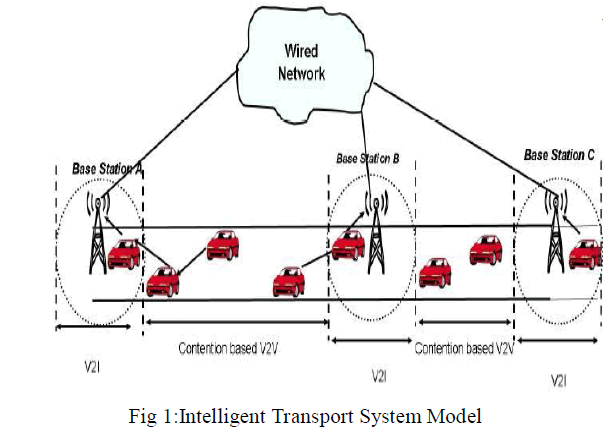 |
| The rest of the paper is organized as follows. Cooperative communication strategies for ITS are presented in Section II. In Section III, the system model is proposed and simulation results on the performance comparison of cooperative techniques are presented in Section IV. Finally, conclusions and discussion are given in Section V. |
II. COOPERATIVE STRATEGIES FOR ITS NETWORKS
|
| In the ITS networks,informations is transmitted using vehicles and existing infrastructure within a network.The communications can occur from road infrastructue to to vehicle (I2V), road infrastructure to road infrastructure (I2I), vehicle to road infrastructure (V2I) or a vehicle to vehicle (V2V). |
| Some cooperative strategies, illustrated in Fig. 2 to Fig. 5,have been proposed for the efficient transmission of data in vehicular networks [10].Consider that the road sign and the vehicle in the transport system is represented respectively by the circle and the rectangle. Considering that the circle and the rectangle stand respectively for the road sign and the vehicle in the transport system, some cooperative transmission strategies, illustrated in Fig. 2 to Fig. 5 , have been proposed for efficient transmissions in ITS communication. |
| A. SISO multihop transmission |
| The most simple cooperation scheme is the multihop SISO transmission, as shown by Fig. 2. Instead of the transmission over a long distance from source node S to the destination node D, a message from a road sign (source node S) at a junction can be transmitted through multiple road signs (cooperation nodes) to a vehicle (destination node D). |
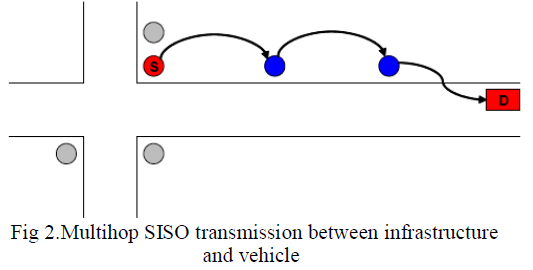 |
| B. Relay transmission |
| In Fig.3, a message from the road sign can be transmitted to the vehicle (destination node D) and another road sign (relay node R). Then, the message is relayed from this relay road sign to the vehicle for signal combination. Transmission diversity gain of relay technique helps to decrease the transmission power for the same error rate requirement, so that reduce the transmission energy consumption. This technique is more energy efficient than multi-hop SISO for medium range transmission. |
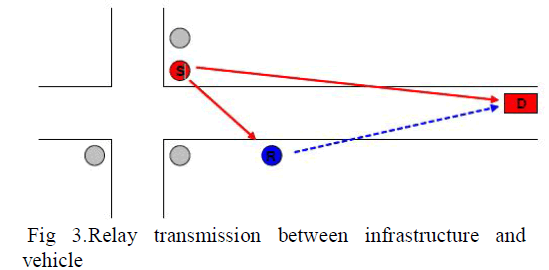 |
| C. Cooperative MIMO transmission |
| Cooperative MIMO technique is an energy efficient cooperative technique for medium and long range transmission [9]. Cooperative MIMO technique exploits the diversity gain of the MIMO space-time coding technique in distributed wireless networks in order to reduce the transmission energy consumption. |
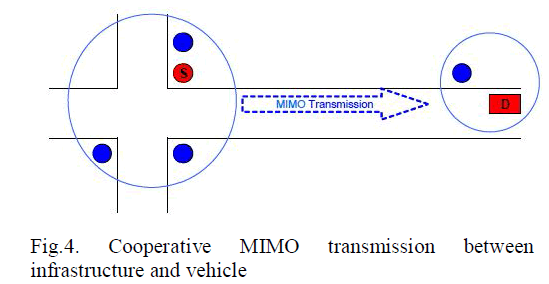 |
| In Fig. 4, it is shown that the road sign node S and the vehicle node D can cooperate with their respective neighbor road signs to employ a cooperative MIMO transmission over a long distance. As the vehicles do not have the surface and energy consumption constraints multiple antennas can be easily integrated in a vehicle to deploy the cooperative MIMO schemes without the need of the cooperative reception phase [8]. |
III. SYSTEM MODEL
|
| Consider a communication link which connects two wireless nodes.One of the major parameter to be considered in the channel is the capacity .When cooperative technique is employed transmission range can be increased in ITS networks as the channel capacity increases. Channel capacity can be calculated by using Shannon-Hartley theorem denoted as |
| (1) |
| where C is measured in bits per second. Assume B is in hertz; the signal and noise powers S and N are measured in watts or volts, so the signal-to-noise ratio here is expressed as a power ratio, not in decibels (dB). |
| Mutual interferences are an important factor in vehicular communication. Interference in vehicular communication cause degradation in the transmission process.Interference is calculated in terms of symbol error rate by using the following equation. |
| (2) |
| where is denoted as the energy per bit to noise power spectral density, is denoted as the channel data rate and as the channel bandwidth. |
IV.PERFORMANCE COMPARISON OF COOPERATIVE TECHNIQUES
|
| In this paper the reference energy model in [11] is used for the performance estimation,evaluation and comparison purposes of cooperative MIMO system. Also the system parameters for the energy consumption are evaluated using Tab.II in [10]. |
| a)Capacity Calculation |
| The cooperative relay and cooperative MIMO techniques can extend the transmission range due to their simplicity and their performance for wireless transmissions over fading channels,therefore both techniques can perform much better than the multihop SISO technique.Thus cooperation between nodes extend the transmission range.Fig.7 represents the channel capacity performance comparison of the relay(Decode –and- Forward technique) and the cooperative MIMO techniques for two transmit nodes with the traditional multihop technique. |
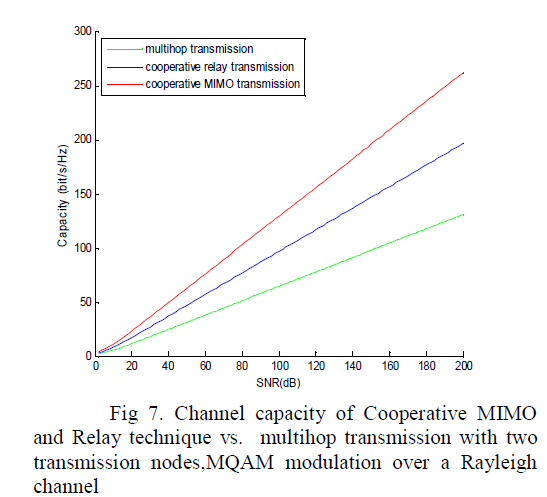 |
| D. Interference Calculation |
| In Fig.8. cooperative techniques vs, multihop technique is compared in terms of interference.It is clearly given that interference can be reduced by cooperative communication in the transmission than employing multihop techniques. |
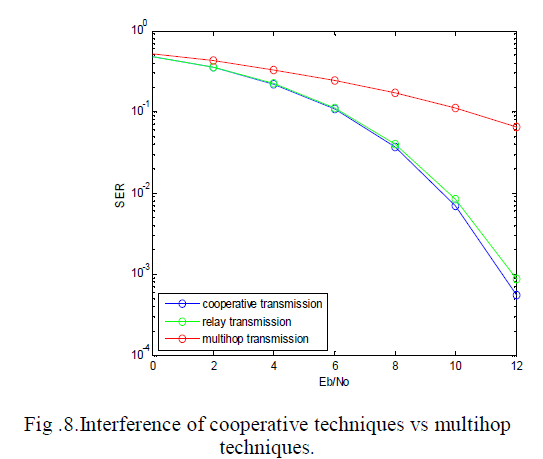 |
V. CONCLUSION
|
| Cooperative techniques can exploit the transmission diversity gain in order to increase the performance in Intelligent Transport Systems.Some cooperative strategies like multihop, cooperative relay and cooperative MIMO techniques, have been proposed in order to deploy efficient transmissions between the road infrastructures and vehicles in vehicular networks. |
| In this paper, it is shown that cooperative relay and MIMO techniques are more efficient than traditional multi-hop SISO techniques for medium and long range transmissions in terms of capacity and interference . |
References
|
- Tuan-Duc Nguyen; Quoc-Bao Vo-Nguyen; Minh-Thanh Vo; Linh Mai, "Energy efficient cooperative communication techniques for Intelligent Transport System," Advanced Technologies for Communications (ATC), 2011 International Conference on , vol., no., pp.76,80, 2-4 Aug. 2011
- J. Laneman and G. Wornell, “Energy-efficient antenna sharing and relaying for wireless networks,” in IEEE Wireless Communications and Networking Conference, WCNC, vol. 1, 2000.
- Sendonaris, E. Erkip, and B. Aazhang, “User cooperation diversity.Part I. System description,” IEEE Transactions on Communications,vol. 51, no. 11, pp. 1927–1938, 2003.
- J. Laneman, D. Tse, and G. Wornell, “Cooperative diversity in wireless networks: Efficient protocols and outage behavior,” IEEE Transactions on Information Theory, vol. 50, no. 12, pp. 3062–3080, 2004.
- M. Dohler, E. Lefranc, and H. Aghvami, “Space-time block codes For virtual antenna arrays,” in The 13th IEEE International Symposium on Personal, Indoor and Mobile Radio Communications, vol. 1, 2002.
- X. Li, “Energy efficient wireless sensor networks with transmission diversity,” Electronics Letters, vol. 39, p. 1753, 2003.
- J. Laneman and G. Wornell, “Distributed space-time-coded Protocols for exploiting cooperative diversity in wireless networks,” IEEE Transactions on Information Theory, vol. 49, no. 10, pp. 2415–2425, 2003.
- T. Nguyen, O. Berder, and O. Sentieys, “Cooperative MIMO schemesoptimal selection for wireless sensor networks,” IEEE 65thVehicular Technology Conference, VTC-Spring 07, pp. 85–89, 2007.
- M. Dohler, E. Lefranc, and H. Aghvami, “Space-time block codes for virtual antenna arrays,” in The 13th IEEE International Symposium on Personal, Indoor and Mobile Radio Communications, vol. 1, 2002.
- 1Tuan-Duc Nguyen; Berder, O.; Sentieys, O., "Energy-Efficient Cooperative Techniques for Infrastructure-to-Vehicle Communications," Intelligent Transportation Systems, IEEE Transactions on , vol.12, no.3, pp.659,668, Sept. 2011.
- S. Cui, A. J. Goldsmith, and A. Bahai, “Modulation Optimization under energy constraints,” in IEEE International Conference on Communications, Anchorage, AK, USA, May 2003,pp. 2805 – 2811.
|